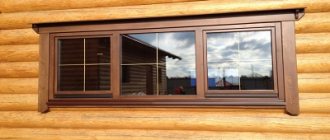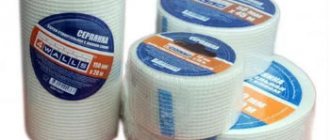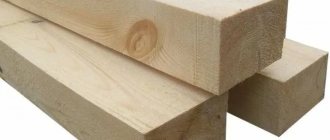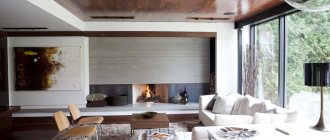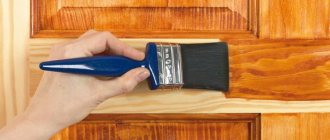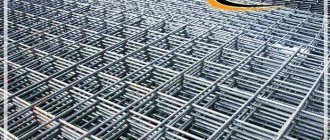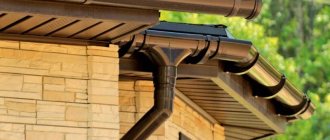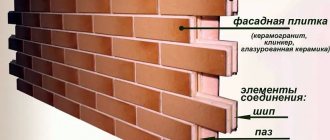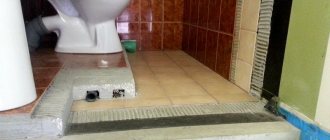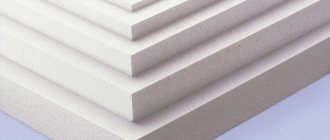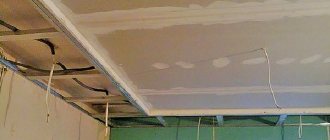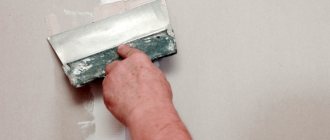One of the problems of apartments in multi-storey buildings is the high level of noise in the room. Unfortunately, not all developers use sound insulation when putting a house into operation. The best option for reducing noise levels is installing high-quality sound insulation. Sound insulation can be installed on almost any wall or ceiling surface. In cases where the area of the apartment is small, and every centimeter is valued, in this case it is worth soundproofing a specific wall, floor or ceiling. By protecting one surface from sound penetration, you can achieve comfort and save available space.
Scheme: soundproofing the ceiling using plasterboard. Author: Artyom Sokov
Today, manufacturers offer a huge selection of soundproofing materials that can be used to work with the ceiling. Classic ceiling cladding with plasterboard sheets, as well as soundproofing components, will help reduce the noise level to the optimal level, thereby providing comfortable living conditions.
Review of sound insulation methods and characteristics of materials
When planning renovations in an apartment, you need to take care in advance about choosing the ceiling and sound insulation for it. As is known, in multi-storey buildings the floors do not have sufficient protection from sounds, so often people living below can hear not only walking on the floor, but even partially speaking. Of course, such conditions are not suitable, because when you come home after work, you want to relax, and not listen to what your neighbors are talking about. High-quality sound insulation of the ceiling will protect the apartment from various sounds.
Photo: Sheathing the finished frame with plasterboard. Author: Artyom Sokov
As you know, there are two types of sounds that can be heard in an apartment: airy and percussive, or as it is also called structural. Sound that is transmitted through the air is called airborne. We hear it when talking, watching TV or when listening to music. Using high-quality and reliable sound insulation, as well as sound-absorbing materials, solving the noise problem will not be difficult.
Another type of sound is percussive or structural. It occurs as a result of vibration. Vibration can be transmitted through solid materials such as walls, thereby creating low-frequency sound. Using modern materials, everything can be done quickly and efficiently.
Advice! It should be understood that the most correct solution for an apartment would be sound insulation of all surfaces: walls, floors and ceilings. Only comprehensive sound insulation will provide comfortable living conditions.
The following products can be used as soundproofing materials:
- mineral wool;
- Natural fiber insulation;
- liquid insulation
- Styrofoam;
- wood based insulation;
- soundproofing membranes;
- vibration suspensions.
Each method has its own characteristics and advantages, so when choosing a suitable sound insulation option, you must carefully weigh the pros and cons.
Mineral wool
Mineral wool and its analogues are considered a good option for soundproofing material. Due to the softness of the material, it perfectly absorbs sounds, creating the required comfortable conditions. One of the advantages of mineral wool is its low cost. If we compare all soundproofing materials, mineral wool has the lowest price. Another advantage of the product is ease of installation. Cotton wool is sold in slabs, which simplifies the process of installing sound insulation on the ceiling.
Photo: Soundproofing with mineral wool. Author: Artyom Sokov
Extruded polystyrene foam (foam)
Foam sheets are considered a reliable insulating material. It can not only reduce noise levels, but also retain heat in the apartment, as it has thermal insulation qualities. When installing foam boards, a special glue is used to ensure high-quality and reliable adhesion to the surface. Despite the fact that polystyrene foam has many analogues in the form of polystyrene, it is worth using the first option. Given the fact that polystyrene is denser and harder, impact noise may continue to be transmitted.
Photo: Polystyrene foam as an insulation material. Author: Artyom Sokov
Natural fiber insulation
Basalt wool is made from natural raw materials. During the manufacturing process, volcanic rock is ground into powder and melted at high temperatures. An air turbine blows up the fine fibers from which the material is formed. This sound insulation is effective due to the fiber base. Each fiber is very thin, due to which the product has a high level of noise absorption. Basalt wool is produced in slabs, which greatly simplifies the process of transportation and installation. It is also worth noting that due to the good passage of air into the noise insulation does not contribute to the formation of fungus or mold, and moisture is simply repelled. Basalt material can be used as sound insulation both inside and outside the apartment. According to professionals, basalt slabs are considered one of the best types of heat and sound insulation.
Photo: Soundproofing with felt. Author: Artyom Sokov
Liquid insulation
When it comes to sound insulation, most people assume to use slabs, sheets or sandwich panels. Today, there are liquid methods of noise and thermal insulation. A special coating in the form of paint is applied to the ceiling, and after drying, the level of heat loss and noise is significantly reduced. The characteristics of the material written on the packaging inspire confidence, since even a thin layer of insulation allows you to obtain all the necessary characteristics for the room. Of course, the opinions of experts differ; some like liquid insulation, while others do not welcome it. This soundproofing option is suitable for those who have little space and low ceilings in their apartment. Using liquid insulation, you can protect it from sound penetration without creating a frame on the ceiling.
Photo: Liquid sound insulation. Author: Artyom Sokov
Wood based insulation
Softboard this material has gained popularity relatively recently. However, those who have once installed sip panels consisting of wood fibers remain satisfied, because in addition to being effective, it is also environmentally friendly, so it can be used in living spaces and children’s rooms. Also among the features of this material is the fact that such slabs can be installed in a frameless manner, which does not entail a significant reduction in ceiling height. In addition to saving space, the installation of wood-based panels does not require a frame, and, therefore, you can save on its manufacture.
Photo: Wood-based insulation. Author: Artyom Sokov
Soundproofing membranes
As a good sound insulator, you can use a membrane lining. The thickness of the rolled web is small, but its characteristics are quite impressive. The membrane is installed not on the frame of the future suspended ceiling, but under it. The material protects the frame structure from vibration sound.
Photo: Soundproofing membrane. Author: Artyom Sokov
Advice! Using a rolled sound insulator, you can create ideal protection from sounds and at the same time save space in the room, since its thickness is small.
Vibration suspensions as a way to improve sound insulation
Currently, vibration suspensions are increasingly used to soundproof ceilings and walls. These devices, despite their simplicity of design, provide effective protection against impact noise. Of course, these devices need to be used in combination, which will give maximum effect. If we talk about the advantages of a vibration suspension, the main advantage is the cost. Today, the market offers a variety of models of vibration suspensions, which can be selected according to characteristics, design and cost.
Photo: Complete soundproofing diagram. Author: Artyom Sokov
Floor soundproofing panel systems ZIPS.
Another option for floor soundproofing is the frameless ZIPS-floor system. These are sandwich panels that are laid on a pre-leveled floor. The disadvantage of this solution is the need to level the floor surface before installing the panels (presence of wet work) and poor sound insulation of the low-frequency component of penetrating noise. The floor will rise by 8–11 cm, depending on the type of panels.
Often, however, a home owner does not need to renovate an entire old floor. This allows for additional insulation between the screed and the floor covering. “These mats are two to six millimeters thick and produce a good percussive sound,” says Herzig
It is important to adjust the insulation to the appropriate surface. “As a general rule: soft floor - soft insulation, hard floor - hard insulation,” says Wallenberg
If the wrong insulation is selected, the floor covering may be damaged. “If the insulation is too soft, for example, there is an unpleasant impression from the furniture or chair.”
Peace and quiet - this is the dream of every resident of an apartment building or a house located near a noisy highway. Fortunately, soundproofing materials, combined with their proper use, will help get rid of all kinds of noise. This is what we will talk about - how to properly apply sound insulation.
Do-it-yourself ceiling soundproofing installation technology
Despite the abundance of soundproofing materials, we will use mineral wool as an example, since this insulator is one of the most common. It is worth understanding that sound insulation using mineral wool involves the manufacture of a frame and subsequent lining with sheets of plasterboard. There is a certain sequence of actions, thanks to which you can complete all installation work in the shortest possible time yourself, without the involvement of specialists.
Photo: Soundproofing process. Author: Artyom Sokov
First, the surface is prepared, then the frame is made, then filled with soundproofing material and covered with plasterboard. Despite the multi-stage work, the production and installation of noise insulation does not take much time, especially if professionals get down to business. As for a beginner, he may need a couple of days to do everything efficiently and reliably.
Procedure for the process of noise insulation of a plasterboard ceiling
Process sequence:
- First, the front position of the frame is marked along the boundaries of the walls. For this, a building level is used.
- The frame mounting brackets are then attached to the ceiling.
- The membrane is attached to the ceiling with glue, after which the frame is mounted.
- Soundproofing material clings to the membrane between the profiles. Then plasterboard panels are attached to the frame profiles.
- A sound-reinforcing line is created in the fastening areas.
- The spaces between sheets of drywall are treated with plaster or moisture-resistant mastic.
Preparing the ceiling for finishing
To obtain high-quality sound insulation, you need to take a responsible approach to the preparatory process. You need to visually inspect the ceiling for cracks and crevices. It is worth understanding that even the slightest defect can let sound into the apartment. If cracks or crevices are found, they must be sealed with plaster. You should also clean the ceiling surface from dust, debris and old finishes, if any.
It is worth understanding that even the slightest peeling of the old layer can negatively affect the protection from extraneous sound. Some craftsmen wash off the residue from the ceiling before starting work to minimize the slightest nuisance.
Important! The overall result of ceiling sound insulation depends on the quality of the preparatory work.
Another stage of preparation is marking. Professional marking specialists use special laser devices that allow them to quickly and accurately take all measurements. If you do not have such equipment, then as an alternative you will have to use a tape measure and plumb lines.
Photo: Soundproofing process. Author: Artyom Sokov
When the markings are made, you can begin directly assembling the frame base on the ceiling. It should be remembered that when assembling an aluminum structure from a profile and attaching it to the ceiling, pieces of sealing tape should be used. Thanks to its use, the level of vibration noise will be reduced to a minimum.
Peculiarities
Most often, special perforated gypsum boards are used for acoustic structures, for example, KNAUF-Acoustics, Soundline-Acoustics, Gyptone Activ Air Point, etc. The holes punched in the sheets can be round or square, their diameter (side length) is 8-12 mm , and the pitch is 18-25 mm.
Perforation makes the sheet permeable to sound and greatly reduces the intensity of the echo (in the language of experts, it increases the reverberation coefficient of sound absorption of the material). The physical essence of the phenomenon is that a sound wave, passing through the holes, is split into parts that collide in the space behind the ceiling and cancel each other out. A slight additional noise reduction is provided by a thin synthetic fabric glued to the back of the sheets.
The result is not the same at different frequencies. Moreover, it depends on the size, shape and relative position of the holes, as well as on the ratio of their area to the area of the sheet (perforation coefficient). The standard thickness of acoustic gypsum boards is 12.5 mm, dimensions are 1200x2000/2500 mm. The non-woven fabric glued to the back can be black or white. The first makes the holes clearly visible, the second masks them - the choice depends on the design idea.
Acoustic gypsum boards should not be confused with soundproofing ones (Gyproc Aku-Line, KNAUF Sapphire, etc.), which differ from conventional ones only in their increased density.
Assembly of aluminum structure
The frame base is assembled in accordance with the applied markings. It should be remembered that the distance between each profile should not exceed the parameters of the mineral wool slabs. To ensure effective sound insulation, the material must be tightly inserted and held, and not fall out of the frame structure. All elements of the frame structure must be securely fastened so that they hold tightly during operation.
Photo: Soundproofing process. Author: Artyom Sokov
After manufacturing the frame, wiring in a special corrugated casing and other communications can be inserted into its structure. After this, soundproofing boards are installed.
Stage 2: membrane sticker and frame installation
Next, you make markings for the frame and glue the membrane sheet onto the primed base. To do this, use a special glue specified in the recommendations for the membrane you have chosen. And now you just install the frame.
Advice: place rubber gaskets at the junctions between the membrane and the fastening itself. This will help protect the canvas from vibrations and improve sound insulation.
© kti.by
Fixation of insulating materials
As already mentioned, mineral wool is made in the form of slabs of a certain size. As a rule, its parameters are 100*60 centimeters. When making a frame, the parameters of the cells must fully correspond to the dimensions of the slabs; only in this case can reliable fixation and effective sound insulation be ensured. Slabs made of mineral material must be compacted into a cell so that the material itself holds without support. When all the slabs are laid, you can cover them with plasterboard sheets.
Photo: Soundproofing process. Author: Artyom Sokov
Drywall installation
Plasterboard slabs are installed using the standard method. The sheet is immediately placed in the far corner of the room. By attaching the sheet to the structure, the last measurement is taken before fixing. Using a screwdriver and self-tapping screws, the plasterboard board is sewn to the frame.
It is important to know! To ensure reliable fixation of the drywall sheet, at least 50 screws should be used per sheet over the entire area.
After laying the first sheet, the installation direction is selected independently. It should be remembered that when working with drywall, it is necessary to keep the seams to a minimum, as they can allow sound to pass into the room. Upon completion of installation work, the resulting seams should be covered with putty using reinforced mesh. A sealant is also an option.
Photo: Soundproofing process. Author: Artyom Sokov
How to soundproof an apartment?
Reliable sound insulation of a room is provided by thick walls and interfloor slabs. In old high-rise buildings, there was practically no sound insulation, so many residents of panel houses independently protect their apartments from noise. This is done by insulating all structural elements (walls, ceilings and floors) with a variety of sound-absorbing materials.
All apartment owners need to know that sounds enter the room through:
- sockets and distribution boxes;
- plumbing and heating system;
- joints and cracks;
- windows and doors.
It is because of this that all the elements described above need to be soundproofed.
Filling voids
When creating and filling a suspended ceiling structure with soundproofing materials, it is necessary to make a kind of pie consisting of several layers: mineral wool, substrate, plasterboard sheets, and can also be supplemented with acoustic versions of materials that will increase the degree of protection. Proper design and implementation of sound insulation will provide the room with comfortable conditions and protect apartment residents from annoying unpleasant sounds.
Interesting! Effective sound insulation can only be achieved through an integrated approach to solving the problem.
Tools for work
For each stage of ceiling soundproofing, various tool options are used. If we talk about preparation and marking, then you will need: a tape measure, a pencil, a ruler, a spatula, a laser meter, scissors for cutting the profile, and a stationery knife. When installing soundproofing materials and drywall sheets, you will need: a screwdriver, a screwdriver, scissors, reinforced tape and a spatula.
The presence of a large selection of soundproofing materials on the market allows you to create ideal protection from external sounds in your own apartment; if you approach the problem correctly, you can independently create the most comfortable conditions in your home.
Noise classification
Noises in an apartment are usually divided into two types: airborne noise (voices, screams, barking dogs) and impact noise (steps, jumping, moving furniture, falling objects, creaks, etc.).
A standard concrete floor slab (hollow-core, 220 mm thick or solid monolithic, 140 mm thick) will provide airborne sound insulation of about 50 dB. The screed will add another 2–3 dB, so the final noise insulation index will be Rw = 52–53 dB. This is enough to block out everyday voice noise, such as conversations or TV. To isolate louder noises (cinema, stereo, screams, barking dogs), additional soundproofing of the ceiling will be required.
In terms of impact noise, things are worse - not a single ceiling meets the standards. For example, a typical 140 mm reinforced concrete floor slab has impact noise insulation that is 20 dB lower than SNiP standards, even for houses of category “B”. Not to mention more comfortable classes of housing! If the floor in the apartment above is not soundproofed, then even barefoot steps will be clearly audible from below. To reduce the noise penetrating into the apartment, suspended soundproofing ceilings are installed on vibration suspensions.
